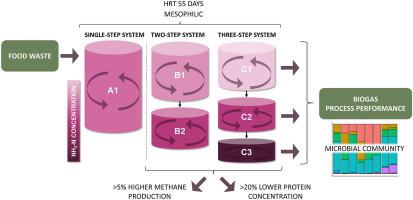Biomass & Bioenergy ( IF 6 ) Pub Date : 2022-05-18 , DOI: 10.1016/j.biombioe.2022.106478 Ebba Perman , Anna Schnürer , Annika Björn , Jan Moestedt

|
Optimization of the biogas generation process is important to achieve efficient degradation and high methane yield, and to reduce methane emissions from the digestate. In this study, serial digester systems with two or three biogas reactors were compared with a single reactor, with the aim of improving degree of degradation and methane yield from food waste and assessing adaptation of microbial communities to different reactor steps. All systems had the same total organic load (2.4 g VS/(L d)) and hydraulic retention time (55 days). Serial systems increased methane yield by >5% compared with the single reactor, with the majority of the methane being obtained from the first-step reactors. Improved protein degradation was also obtained in serial systems, with >20% lower outgoing protein concentration compared with the single reactor and increasing NH4+-N concentration with every reactor step. This resulted in separation of high ammonia (>384 mg NH3-N/L) levels from the main methane production, reducing the risk of methanogen inhibition. Methanosarcina dominated the methanogenic community in all reactors, but increases in the hydrogenotrophic genera Methanoculleus and Methanobacterium were observed at higher ammonia levels. Potential syntrophic acetate-oxidizing bacteria, such as MBA03 and Dethiobacteraceae, followed the same trend as the hydrogenotrophic methanogens. Phylum Bacteroidota family Paludibacteraceae was highly abundant in the first steps and then decreased abruptly, potentially linked to an observed decrease in degradation in the last-step reactors. Nevertheless, the results indicated a trend of increasing relative abundance of the potentially proteolytic genera Proteiniphilum and Fastidiosipila with successive reactor steps.
中文翻译:

连续厌氧消化改善混合食物垃圾的蛋白质降解和沼气生产
沼气生产过程的优化对于实现高效降解和高甲烷产量以及减少沼渣的甲烷排放非常重要。在这项研究中,将具有两个或三个沼气反应器的串联消化系统与单个反应器进行了比较,目的是提高食物垃圾的降解程度和甲烷产量,并评估微生物群落对不同反应器步骤的适应性。所有系统具有相同的总有机负荷 (2.4 g VS/(L d)) 和水力停留时间 (55 天)。与单反应器相比,串联系统将甲烷产率提高了 5% 以上,其中大部分甲烷来自第一级反应器。在串行系统中也获得了改进的蛋白质降解,具有 >每个反应器步骤的4 + -N 浓度。这导致高水平的氨(>384 mg NH 3 -N/L)从主要的甲烷生产中分离出来,从而降低了产甲烷菌抑制的风险。在所有反应堆中, Methanosarcina在产甲烷群落中占主导地位,但在氨水平较高时观察到氢营养属Methanoculleus和Methanobacterium的增加。潜在的乙酸盐氧化细菌,如 MBA03 和Dethiobacteraceae,与氢营养产甲烷菌具有相同的趋势。拟杆菌门在第一步中非常丰富,然后突然减少,这可能与观察到的最后一步反应器中降解的减少有关。然而,结果表明随着连续的反应器步骤增加潜在的蛋白水解属Proteiniphilum和Fastidiosipila的相对丰度的趋势。



























 京公网安备 11010802027423号
京公网安备 11010802027423号